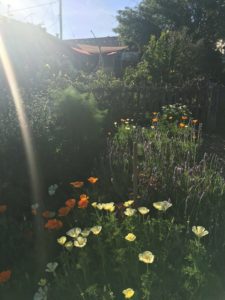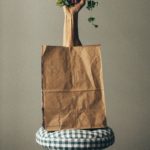Food is Free Benicia Shares Bounty with Foodstand
By Heather Pierini, Food Forest Keeper and Food is Free Benicia

I grew up gardening. My grandparents grew a vast (to me) backyard garden with rows of peppers and tomatoes and onions and every other vegetable that I ignored because I didn’t like those as much. I would sit in the shade of the plants during the hot Central Valley summer and eat tomatoes fresh from the vine or peppers straight from the plant. The smell of hot soil, tomato leaves and humus; the sharp, sweet taste of warm vine-ripe tomatoes; the humidity of the garden are some of my most treasured memories.
My grandparents lived through the Great Depression. They were incapable of seeing anything go to waste. We made sauces and canned them. We made preserves and jams and jellies. We brined olives and ate them year round. My grandmother washed every container to come through her kitchen to reuse. Every plastic bag was washed and hung to dry on clips over the sink. To do any less was wasteful. But even with the help of grandchildren, there was inevitably too much for one family. This is where my favorite part of the summer came in.
Whenever someone walked by, my grandfather would chat with them over the fence. By the end of the conversation they would be loaded down with zucchini and tomatoes. If they were particularly nice, maybe even a jar of olives. I was graced to grow up seeing that a garden can be a gathering spot for a chat, a connection point for the neighborhood and a bounteous source of food for those who choose to share.
Now I am in the privileged position of having a large, south-facing, sun-drenched backyard with plenty of room to indulge in nostalgia and add my own twist. Several years ago I read about a garden stand with the slogan #foodisfree. I dug a little deeper and found the Food is Free Project based in Austin, Texas. From the website: “The Food is Free Project is a worldwide movement of people growing and sharing food freely. We encourage connecting with your neighbors by planting a front yard garden or sharing your harvest with a #foodisfree table.” This was the first time I had heard of people organizing how to share excess homegrown food but in a very organic, low-key way.
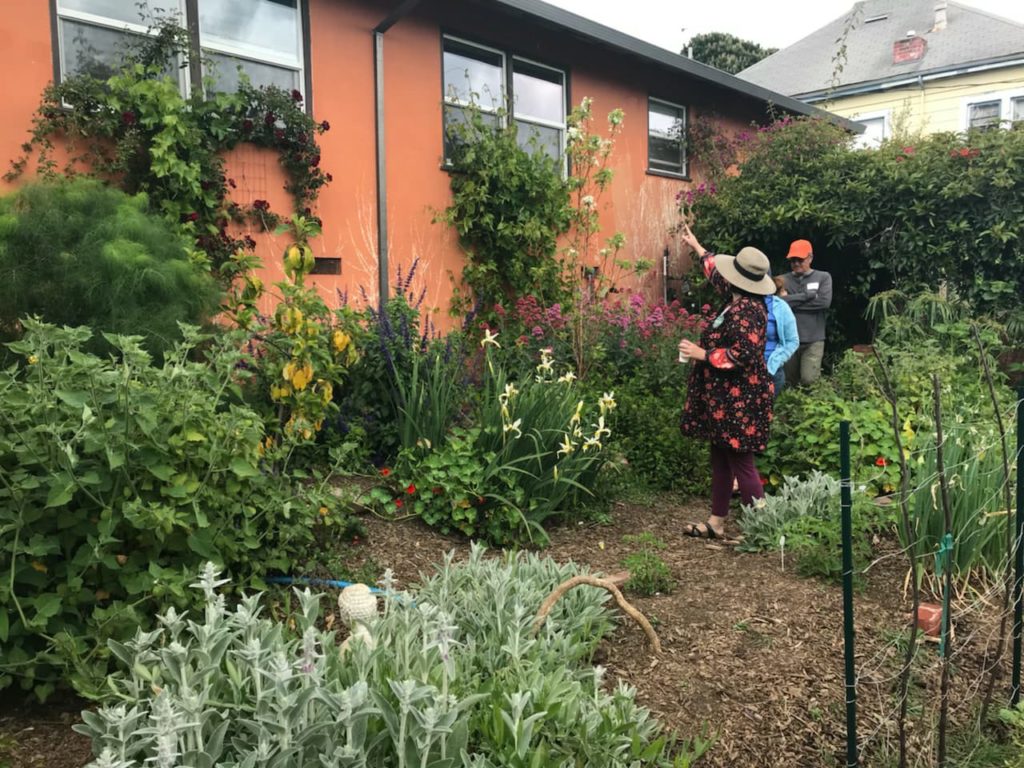
Heather’s Birds, Bees & Beyond garden
About five years ago, I started putting extra food on a toddler’s table at my sidewalk with a paper sign taped on that said #foodisfree. Fairly often someone would grab the food, but I was rarely there to chat or connect. Two years ago, I found a wonderful wooden display stand and decided to repurpose that as my “foodstand.” I added a chalkboard with a larger #foodisfree sign. More people came, and I got to chat with some of them.
This year has been different. I am struggling with health issues that keep me from my garden. In June I still put the garden stand up, hoping to fill it with produce that grows even without my help. Not much got put into the stand. In July I fell in the garden and ended up with a fracture in my leg. I was banished from the uneven ground of the garden and ended up sitting on my couch feeling sorry for myself. Then someone dropped off some squash and cucumbers. I was delighted. It was the most fun I’d had in days. There’s not much to be entertained by in the summer with a broken leg. I decided I would start a Facebook page for my food stand.
Food is Free Benicia was officially created! It turns out that a lovely woman, Barbara, who had enjoyed the food I shared in previous years, decided to drop off the produce. I put up some pictures and shared the link to several local groups and the page has taken off. Now the stand is fairly self-sustaining with dropoffs and pickups happening several times a day. I post what food is available, usage ideas and garden-related information. The Food is Free Benicia Facebook page now has over 200 followers. It has expanded from just produce to spices, herbs and canned goods. I met a lovely young woman interested in starting a #foodisfree stand at her apartment building. We got together and I shared some of the things I have learned and offered to help in any way. Food is Free Benicia Waterview is now open!
My leg is almost healed now and I am back in the garden with renewed energy due to the influx of visitors. My daughter helped me paint an old bench from the backyard and we moved it up by the stand. Now, when someone stops to grab an apple they can sit in the shade and enjoy the garden. I have had the chance to meet many of the garden visitors lately. One older gentleman, David, bikes past every day. I often see him stop, grab a few apples or pears, eat them and drop the cores in the compost bucket. Today I was heading out on an errand and guess who was resting on the bench? Yep, David. It turns out he bikes daily for exercise but often gets tired midway. Our stand offered a quick blood sugar boost and now a lovely spot to sit as well.
I am excited to share the foodstand with our community. It has given me much joy and happiness during a very difficult time. I can’t wait to see what the future has in store.
Food is Free Benicia Holds
Swapluck Garden Party
Food is Free Benicia will host its first Swapluck from 11 am-2 pm Sunday, Sept. 22.
Join others who are interested in sharing abundance for swapping and sharing seeds, plants, cuttings, food and whatever else you would like. No gathering is complete without food, so bring a dish to share. (You do not have to bring anything to participate.)
Heather Pierini is a food forest keeper through Sustainable Solano’s Benicia Sustainable Backyards program. Her garden, ‘Birds, Bees & Beyond,’ is on our annual tour of permaculture food forest gardens, and now home to Food is Free Benicia.

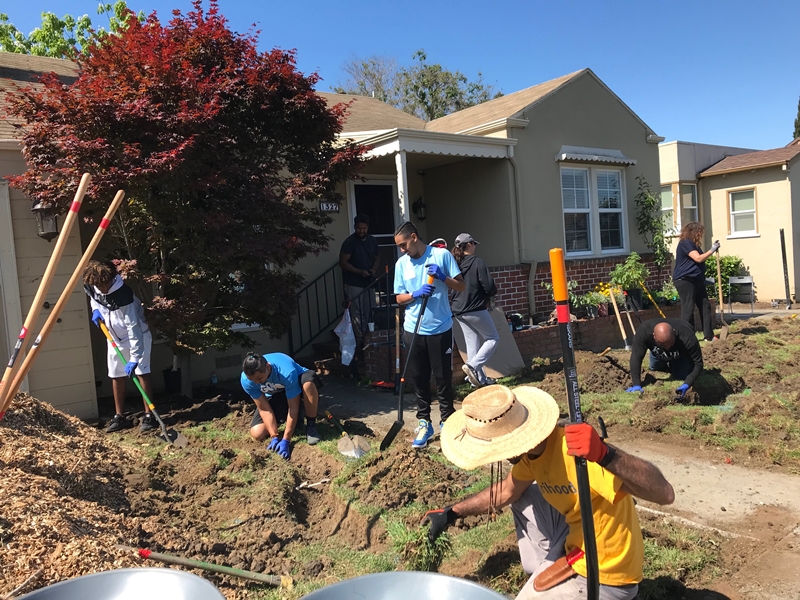


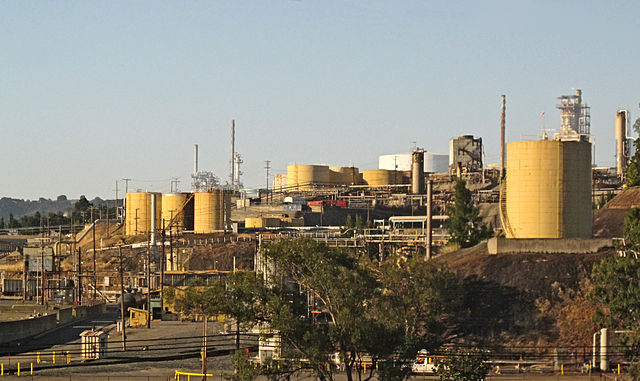
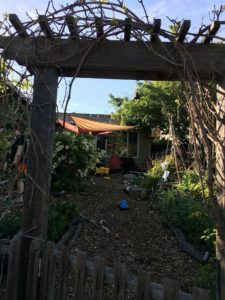
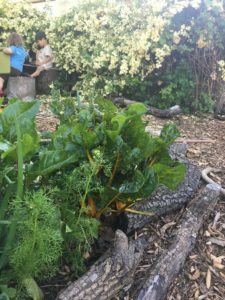 In 2015, Benicia residents, Rob and Nam, submitted an application to have their yard transformed into a demonstration food forest garden, fed by secondary water (laundry-to-landcape greywater system & roofwater). This edible ecosystem would serve as a sustainable food source for their family and an educational platform for the community to learn about sustainable landscape design and wise water practices as part of the Benicia Sustainable Backyard program. This March marked the third anniversary of the installation of “Greyhawk Grove” garden. Below is a beautiful account from the homeowner of the journey and recent reflections of her family’s interaction with their food forest garden.
In 2015, Benicia residents, Rob and Nam, submitted an application to have their yard transformed into a demonstration food forest garden, fed by secondary water (laundry-to-landcape greywater system & roofwater). This edible ecosystem would serve as a sustainable food source for their family and an educational platform for the community to learn about sustainable landscape design and wise water practices as part of the Benicia Sustainable Backyard program. This March marked the third anniversary of the installation of “Greyhawk Grove” garden. Below is a beautiful account from the homeowner of the journey and recent reflections of her family’s interaction with their food forest garden.